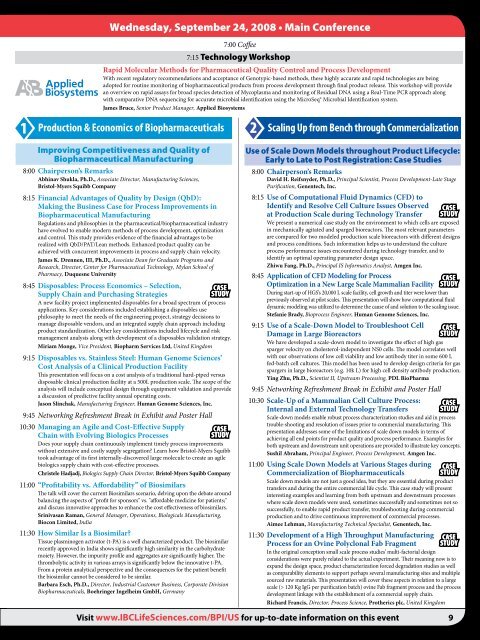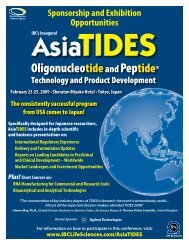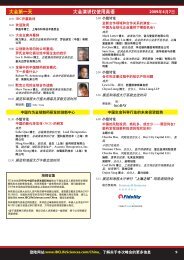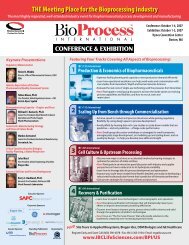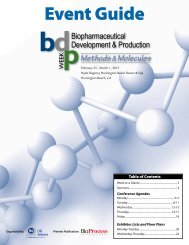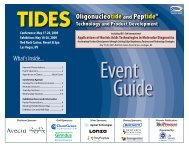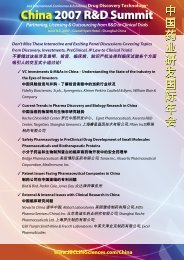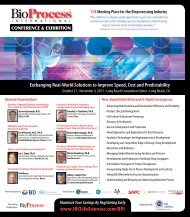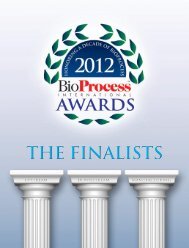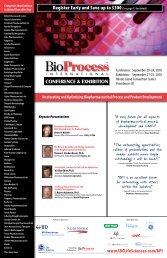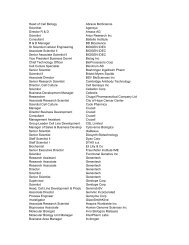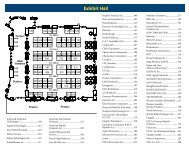Cell Culture & Upstream Processing - IBC Life Sciences
Cell Culture & Upstream Processing - IBC Life Sciences
Cell Culture & Upstream Processing - IBC Life Sciences
You also want an ePaper? Increase the reach of your titles
YUMPU automatically turns print PDFs into web optimized ePapers that Google loves.
Wednesday, September 24, 2008 • Main Conference<br />
Improving Competitiveness and Quality of<br />
Biopharmaceutical Manufacturing<br />
8:00 Chairperson’s Remarks<br />
Abhinav Shukla, Ph.D., Associate Director, Manufacturing <strong>Sciences</strong>,<br />
Bristol-Myers Squibb Company<br />
8:15 Financial Advantages of Quality by Design (QbD):<br />
Making the Business Case for Process Improvements in<br />
Biopharmaceutical Manufacturing<br />
Regulations and philosophies in the pharmaceutical/biopharmaceutical industry<br />
have evolved to enable modern methods of process development, optimization<br />
and control. This study provides evidence of the financial advantages to be<br />
realized with QbD/PAT/Lean methods. Enhanced product quality can be<br />
achieved with concurrent improvements in process and supply chain velocity.<br />
James K. Drennen, III, Ph.D., Associate Dean for Graduate Programs and<br />
Research, Director, Center for Pharmaceutical Technology, Mylan School of<br />
Pharmacy, Duquesne University<br />
8:45 Disposables: Process Economics – Selection,<br />
Supply Chain and Purchasing Strategies<br />
CASE<br />
STUDY<br />
A new facility project implemented disposables for a broad spectrum of process<br />
applications. Key considerations included establishing a disposables use<br />
philosophy to meet the needs of the engineering project, strategy decisions to<br />
manage disposable vendors, and an integrated supply chain approach including<br />
product standardization. Other key considerations included lifecycle and risk<br />
management analysis along with development of a disposables validation strategy.<br />
Miriam Monge, Vice President, Biopharm Services Ltd, United Kingdom<br />
9:15 Disposables vs. Stainless Steel: Human Genome <strong>Sciences</strong>’<br />
Cost Analysis of a Clinical Production Facility<br />
This presentation will focus on a cost analysis of a traditional hard-piped versus<br />
disposable clinical production facility at a 500L production scale. The scope of the<br />
analysis will include conceptual design through equipment validation and provide<br />
a discussion of predictive facility annual operating costs.<br />
Jason Slinchak, Manufacturing Engineer, Human Genome <strong>Sciences</strong>, Inc.<br />
9:45 Networking Refreshment Break in Exhibit and Poster Hall<br />
10:30 Managing an Agile and Cost-Effective Supply<br />
Chain with Evolving Biologics Processes<br />
CASE<br />
STUDY<br />
Does your supply chain continuously implement timely process improvements<br />
without extensive and costly supply segregation? Learn how Bristol-Myers Squibb<br />
took advantage of its first internally-discovered large molecule to create an agile<br />
biologics supply chain with cost-effective processes.<br />
Christele Hadjadj, Biologics Supply Chain Director, Bristol-Myers Squibb Company<br />
11:00 “Profitability vs. Affordability” of Biosimilars<br />
The talk will cover the current Biosimilars scenario, delving upon the debate around<br />
balancing the aspects of "profit for sponsors" vs. "affordable medicine for patients;"<br />
and discuss innovative approaches to enhance the cost effectiveness of biosimilars.<br />
Srinivasan Raman, General Manager, Operations, Biologicals Manufacturing,<br />
Biocon Limited, India<br />
11:30 How Similar Is a Biosimilar?<br />
Tissue plasminogen activator (t-PA) is a well characterized product. The biosimilar<br />
recently approved in India shows significantly high similarity in the carbohydrate<br />
moiety. However, the impurity profile and aggregates are significantly higher. The<br />
thrombolytic activity in various arrays is significantly below the innovative t-PA.<br />
From a protein analytical perspective and the consequences for the patient benefit<br />
the biosimilar cannot be considered to be similar.<br />
Barbara Esch, Ph.D., Director, Industrial Customer Business, Corporate Division<br />
Biopharmaceuticals, Boehringer Ingelheim GmbH, Germany<br />
7:00 Coffee<br />
7:15 Technology Workshop<br />
Rapid Molecular Methods for Pharmaceutical Quality Control and Process Development<br />
With recent regulatory recommendations and acceptance of Genotypic-based methods, these highly accurate and rapid technologies are being<br />
adopted for routine monitoring of biopharmaceutical products from process development through final product release. This workshop will provide<br />
an overview on rapid assays for broad species detection of Mycoplasma and monitoring of Residual DNA using a Real-Time PCR approach along<br />
with comparative DNA sequencing for accurate microbial identification using the MicroSeq® Microbial Identification system.<br />
James Bruce, Senior Product Manager, Applied Biosystems<br />
1 Production & Economics of Biopharmaceuticals 2 Scaling Up from Bench through Commercialization<br />
Use of Scale Down Models throughout Product <strong>Life</strong>cycle:<br />
Early to Late to Post Registration: Case Studies<br />
8:00 Chairperson’s Remarks<br />
David H. Reifsnyder, Ph.D., Principal Scientist, Process Development-Late Stage<br />
Purification, Genentech, Inc.<br />
8:15 Use of Computational Fluid Dynamics (CFD) to<br />
Identify and Resolve <strong>Cell</strong> <strong>Culture</strong> Issues Observed<br />
at Production Scale during Technology Transfer<br />
CASE<br />
STUDY<br />
We present a numerical case study on the environment to which cells are exposed<br />
in mechanically agitated and sparged bioreactors. The most relevant parameters<br />
are compared for two modeled production scale bioreactors with different designs<br />
and process conditions. Such information helps us to understand the culture<br />
process performance issues encountered during technology transfer, and to<br />
identify an optimal operating parameter design space.<br />
Zhiwu Fang, Ph.D., Principal IS Informatics Analyst, Amgen Inc.<br />
8:45 Application of CFD Modeling for Process<br />
Optimization in a New Large Scale Mammalian Facility<br />
CASE<br />
STUDY<br />
During start-up of HGS’s 20,000 L scale facility, cell growth and titer were lower than<br />
previously observed at pilot scales. This presentation will show how computational fluid<br />
dynamic modeling was utilized to determine the cause of and solution to the scaling issue.<br />
Stefanie Brady, Bioprocess Engineer, Human Genome <strong>Sciences</strong>, Inc.<br />
9:15 Use of a Scale-Down Model to Troubleshoot <strong>Cell</strong><br />
Damage in Large Bioreactors<br />
CASE<br />
STUDY<br />
We have developed a scale-down model to investigate the effect of high gas<br />
sparger velocity on cholesterol-independent NS0 cells. The model correlates well<br />
with our observations of low cell viability and low antibody titer in some 600 L<br />
fed-batch cell cultures. This model has been used to develop design criteria for gas<br />
spargers in large bioreactors (e.g. 10k L) for high cell density antibody production.<br />
Ying Zhu, Ph.D., Scientist II, <strong>Upstream</strong> <strong>Processing</strong>, PDL BioPharma<br />
9:45 Networking Refreshment Break in Exhibit and Poster Hall<br />
10:30 Scale-Up of a Mammalian <strong>Cell</strong> <strong>Culture</strong> Process:<br />
Internal and External Technology Transfers<br />
CASE<br />
STUDY<br />
Scale-down models enable robust process characterization studies and aid in process<br />
trouble-shooting and resolution of issues prior to commercial manufacturing. This<br />
presentation addresses some of the limitations of scale down models in terms of<br />
achieving all end points for product quality and process performance. Examples for<br />
both upstream and downstream unit operations are provided to illustrate key concepts.<br />
Sushil Abraham, Principal Engineer, Process Development, Amgen Inc.<br />
11:00 Using Scale Down Models at Various Stages during<br />
Commercialization of Biopharmaceuticals<br />
CASE<br />
STUDY<br />
Scale down models are not just a good idea, but they are essential during product<br />
transfers and during the entire commercial life cycle. This case study will present<br />
interesting examples and learning from both upstream and downstream processes<br />
where scale down models were used, sometimes successfully and sometimes not so<br />
successfully, to enable rapid product transfer, troubleshooting during commercial<br />
production and to drive continuous improvement of commercial processes.<br />
Aimee Lehman, Manufacturing Technical Specialist, Genentech, Inc.<br />
11:30 Development of a High Throughput Manufacturing<br />
Process for an Ovine Polyclonal Fab Fragment<br />
CASE<br />
STUDY<br />
In the original conception small scale process studies’ multi-factorial design<br />
considerations were purely related to the actual experiment. Their meaning now is to<br />
expand the design space, product characterization forced degradation studies as well<br />
as comparability elements to support perhaps several manufacturing sites and multiple<br />
sourced raw materials. This presentation will cover these aspects in relation to a large<br />
scale (> 120 Kg IgG per purification batch) ovine Fab fragment process and the process<br />
development linkage with the establishment of a commercial supply chain.<br />
Richard Francis, Director, Process Science, Protherics plc, United Kingdom<br />
Visit www.<strong>IBC</strong><strong>Life</strong><strong>Sciences</strong>.com/BPI/US for up-to-date information on this event 9


